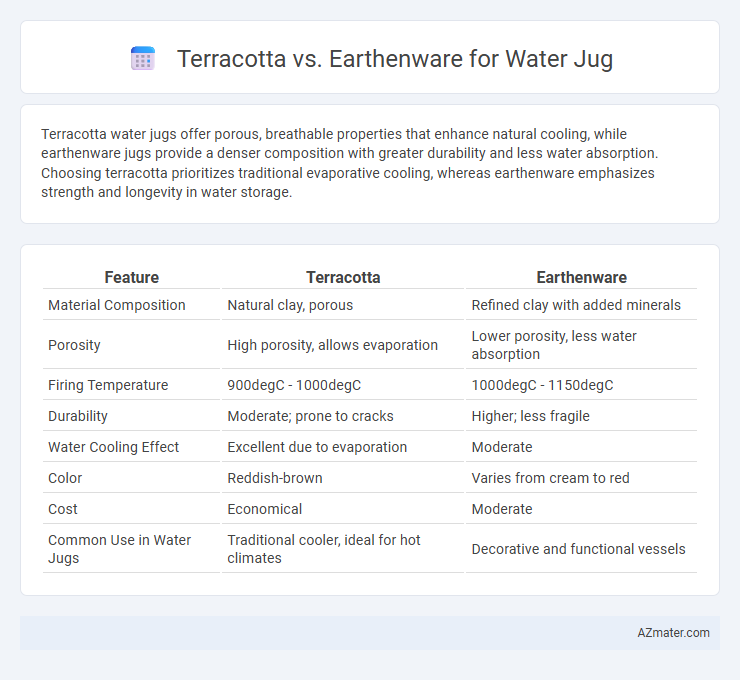Terracotta water jugs offer porous, breathable properties that enhance natural cooling, while earthenware jugs provide a denser composition with greater durability and less water absorption. Choosing terracotta prioritizes traditional evaporative cooling, whereas earthenware emphasizes strength and longevity in water storage.
Table of Comparison
| Feature | Terracotta | Earthenware |
|---|---|---|
| Material Composition | Natural clay, porous | Refined clay with added minerals |
| Porosity | High porosity, allows evaporation | Lower porosity, less water absorption |
| Firing Temperature | 900degC - 1000degC | 1000degC - 1150degC |
| Durability | Moderate; prone to cracks | Higher; less fragile |
| Water Cooling Effect | Excellent due to evaporation | Moderate |
| Color | Reddish-brown | Varies from cream to red |
| Cost | Economical | Moderate |
| Common Use in Water Jugs | Traditional cooler, ideal for hot climates | Decorative and functional vessels |
Introduction to Terracotta and Earthenware
Terracotta and earthenware are both traditional clay-based materials commonly used for making water jugs, valued for their natural porous properties which help keep water cool. Terracotta, typically made from red or brown clay, is fired at lower temperatures resulting in a porous and somewhat brittle texture ideal for breathability and moisture retention. Earthenware, fired at similar or slightly higher temperatures, often features a glazed surface to reduce porosity, offering more durability and resistance to water absorption while maintaining an earthy aesthetic.
Material Composition and Properties
Terracotta water jugs are made from porous clay fired at low temperatures, resulting in a slightly rough texture that allows slow evaporation to naturally cool the water. Earthenware jugs consist of similar clay materials but often include added minerals or tempering agents, enhancing durability while maintaining porosity. Both materials excel in breathability and thermal insulation, but terracotta's higher porosity offers superior cooling effects, whereas earthenware provides improved resistance to chipping and cracking.
Traditional Uses of Water Jugs
Terracotta water jugs, traditionally crafted from porous clay, are renowned for their natural cooling properties, making them ideal for storing and cooling water in hot climates. Earthenware water jugs, while also made from clay, are typically glazed to improve durability and prevent seepage, preserving water freshness during storage. Both materials have been used for centuries in rural and agricultural communities to hydrate and cool water naturally without modern refrigeration.
Water Cooling Efficiency: Terracotta vs Earthenware
Terracotta water jugs offer superior water cooling efficiency due to their porous structure, allowing natural evaporation that cools the water inside. Earthenware, being less porous and often glazed, has reduced permeability, which limits this evaporative cooling effect. Consequently, terracotta jugs are preferred for maintaining cooler water temperatures in hot climates compared to earthenware counterparts.
Durability and Lifespan Comparison
Terracotta water jugs are made from porous clay that is fired at lower temperatures, resulting in moderate durability but greater susceptibility to cracks and breakage over time. Earthenware, fired at slightly higher temperatures, offers enhanced strength and resistance to wear, leading to a longer lifespan for water jugs compared to terracotta. When selecting between the two, earthenware water jugs provide a more durable and long-lasting option suitable for daily use and outdoor environments.
Porosity and Water Filtration Benefits
Terracotta water jugs exhibit lower porosity compared to traditional earthenware, allowing for better slow water seepage that naturally cools the water while minimizing leakage. The micro-porous structure of terracotta enhances natural filtration by trapping impurities and improving taste, making it more effective for water purification. Earthenware, with higher porosity, tends to absorb more water, reducing durability and potentially allowing contaminants to penetrate, which limits its effectiveness in water filtration.
Aesthetic Appeal and Cultural Significance
Terracotta water jugs offer a warm, rustic aesthetic with their natural reddish-brown hues and porous texture, often associated with traditional craftsmanship in Mediterranean and South Asian cultures. Earthenware jugs, typically glazed, provide a smoother finish and broader color palette, reflecting diverse regional artistry from civilizations such as the Native American and European pottery traditions. Both materials embody cultural heritage, with terracotta symbolizing ancient artisanal authenticity and earthenware representing evolving ceramic techniques that blend functionality with decorative expression.
Maintenance and Cleaning Tips
Terracotta water jugs require gentle cleaning with a soft brush and mild detergent to prevent surface damage and maintain breathability, while earthenware jugs benefit from regular rinsing with warm water to avoid residue buildup. Avoid soaking terracotta items for prolonged periods as they can absorb water and weaken, whereas earthenware tends to be less porous but may chip if handled roughly during cleaning. Both materials should be air-dried completely to prevent mold growth and ensure longevity.
Environmental Impact and Sustainability
Terracotta water jugs, made from natural clay and fired at lower temperatures, have a smaller carbon footprint compared to earthenware, which often includes added materials and higher firing temperatures. Both materials are biodegradable and non-toxic, but terracotta's porous structure enhances breathability without synthetic coatings, promoting eco-friendliness and sustainable water storage. Reusability and local sourcing of terracotta contribute to reduced transportation emissions and waste, positioning it as the more environmentally sustainable option for water containers.
Choosing the Best Material for Your Water Jug
Terracotta water jugs, made from porous clay, offer natural cooling properties by allowing water to evaporate through their walls, making them ideal for hot climates. Earthenware jugs are less porous and often glazed, providing better durability and easier cleaning but reduced breathability compared to terracotta. Choosing the best material depends on prioritizing either natural cooling and aesthetic appeal (terracotta) or enhanced durability and maintenance convenience (earthenware).

Infographic: Terracotta vs Earthenware for Water Jug
 azmater.com
azmater.com